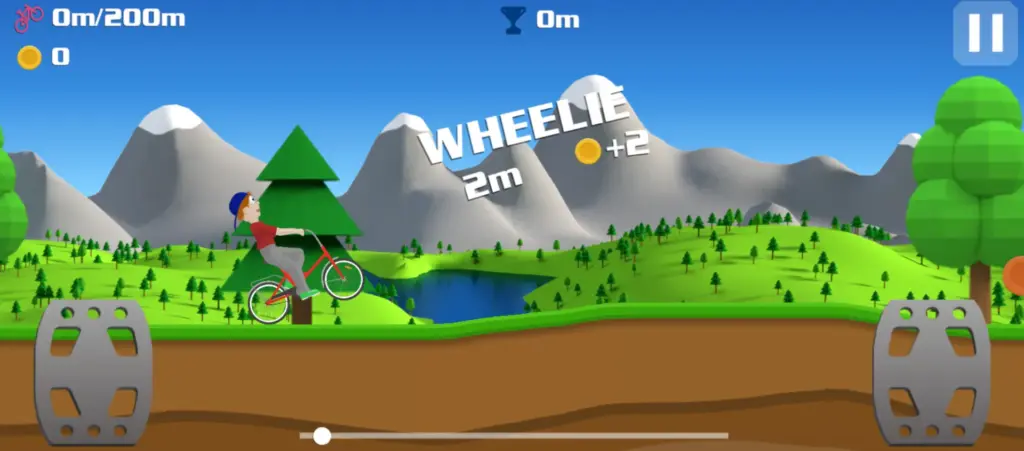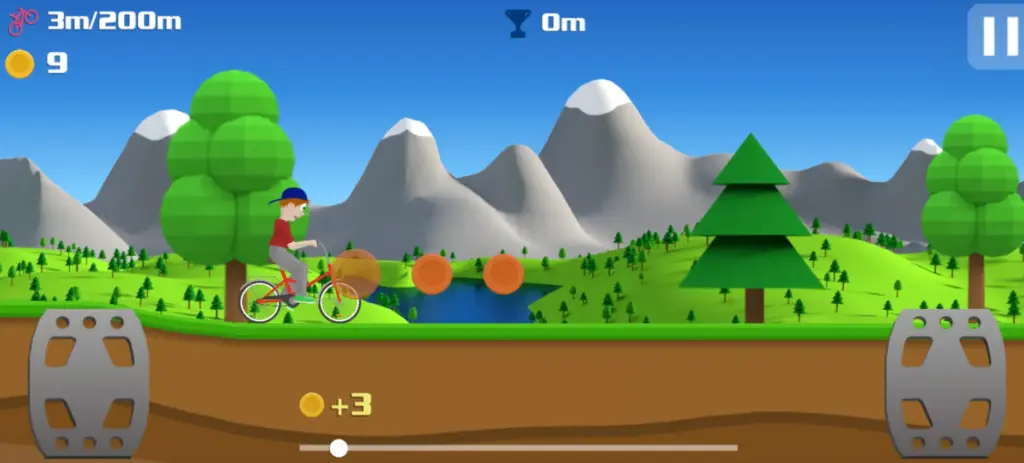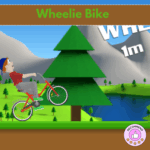Wheelie Bike — Why This Balancing Challenge Belongs in Memory Games
Wheelie Bike is more than a fun stunt game — it’s a test of timing, pattern recall, and muscle-memory-like control. While it may look like a simple biking or arcade title at first glance, Wheelie Bike maps cleanly to the Memory Games category because success depends on remembering level rhythms, sequencing throttle and brake inputs, and executing practiced balance corrections without conscious calculation. This long-form guide explains Wheelie Bike in depth: how it plays, why it fits into Memory Games, strategies for rapid improvement, practice drills that build muscle memory, device and accessibility tips, classroom uses, troubleshooting, and more.
What Is Wheelie Bike?
Wheelie Bike is a reaction-and-balance game in which players ride a bicycle or motorcycle across uneven terrain while maintaining a wheelie or carefully controlling balance through obstacles. Each level places new physical and timing challenges in front of the player: ramps, gaps, low ceilings, and moving hazards. The objective in Wheelie Bike is to reach the finish line intact, often while keeping the front wheel elevated or performing controlled drifts. Simple controls hide deep skill requirements that reward repetition and memorization.

Why Wheelie Bike Fits the Memory Games Category
At its core, Wheelie Bike asks players to internalize sequences of movements and to react with near-automatic precision. That’s the hallmark of memory-based skill:
- Pattern Recall: Levels in Wheelie Bike repeat obstacle layouts and rhythms that can be memorized to produce faster, safer runs.
- Muscle Memory: The small, repeated corrections to your throttle, rear brake, or tilt in Wheelie Bike become automatic with practice — the same process used in classic memory games that rely on repetition.
- Sequence Timing: Many Wheelie Bike segments require you to execute a chain of inputs at precise intervals; remembering these timing windows is a cognitive activity akin to sequencing in memory tasks.
- Trial-and-Error Learning: Players iterate, remember what failed, and apply the correct sequence in the next attempt — a memory-driven improvement loop.
For these reasons, Wheelie Bike belongs comfortably in the Memory Games category: its mechanics emphasize recall, practiced response patterns, and reduced cognitive load through repetition-based learning.
Core Controls and Mechanics
Wheelie Bike typically uses a small, intuitive control set. Understanding the controls is the first step toward creating reliable motor patterns:
- Throttle / Accelerate: Press to increase speed; used to pop wheelies and clear small gaps.
- Brake / Reverse: Tap lightly to slow or shift weight backward to correct a forward pitch.
- Tilt / Lean: Some versions let you tilt the rider forward or back to control balance mid-air.
- Restart: A single key or button restarts the level after a crash — useful for rapid repetition loops when training.
These simple inputs combine into timing-dependent sequences. In Wheelie Bike, the best players often don’t think about each keypress — their hands and fingers remember the sequence and execute it automatically.
How to Play Wheelie Bike — Step by Step
- Start a level and observe the first few obstacles to get a feel for the rhythm.
- Use small throttle taps to maintain a controlled wheelie when needed.
- Apply gentle braking or lean adjustments to prevent over-rotation on landings.
- Watch for repeating patterns; aim to internalize each pattern after several attempts.
- Restart quickly after a crash and implement what you learned on the next run.

By repeating this loop, your brain and body develop the memory traces necessary to perform sequences in Wheelie Bike reliably.
Beginner Tips for Wheelie Bike Players
If you’re new to Wheelie Bike, follow these pragmatic tips to build your skills without frustration:
- Start slow: Focus on balance rather than speed — speed comes after you can keep the wheelie steady.
- Observe before acting: Watch the layout for one attempt even if you don’t move — memorizing the first pattern reduces trial waste.
- Small corrections: Use micro-adjustments to the throttle and brake; big inputs tend to overshoot and force resets.
- Short practice loops: Repeat short sections until you can pass them three times in a row — that’s a strong signal of memory consolidation.
These habits will reduce frustration and quickly grow your competence in Wheelie Bike.
Intermediate Strategies — Building Consistency
Once you’ve learned the basics of Wheelie Bike, focus on consistency and predictable responses:
- Segmented Practice: Break levels into 10–30 second segments and drill the toughest parts until they become automatic.
- Forced Deliberation: Occasionally slow down to consciously rehearse inputs — this strengthens memory before returning to speed runs.
- Timing Anchors: Use visual landmarks on the track as anchors for when to begin and end inputs in Wheelie Bike.
- Reduce Variance: Use the same input device during practice blocks to lower performance noise and speed up memory formation.
Advanced Techniques — Mastering Wheelie Bike
For players aiming to set records or reach top leaderboards, advanced memorization techniques make the difference:
- Chunking: Group sequences into chunks (for example, “pop, hold, release”) and practice each chunk until transitions are fluid.
- Internal Rhythms: Count silently or hum a rhythm that matches the timing windows — the rhythm becomes a mnemonic for input cadence.
- Variability Training: Slightly vary input timing in practice to build robust memory that tolerates minor deviations during real runs.
- Video Review: Record runs and watch frame-by-frame to spot where your timing drifts; then rehearse the corrected sequence in Wheelie Bike.
Practice Drills to Build Muscle Memory
The right drills accelerate your progress in Wheelie Bike by targeting memory consolidation directly:
- Micro-repeat Drill: Pick a 5–10 second obstacle segment and repeat it 20–30 times until the sequence feels automatic.
- Anchored Rhythm Drill: Select a visual anchor each time you begin a wheelie and practice initiating the input at that anchor for 15 repetitions.
- Reverse Walkthrough: Start from the end of a difficult segment and perform it backwards (in terms of practice steps) to force your brain to encode the full sequence context.
- Variable Delay Drill: Intentionally vary the delay between inputs while practicing so your memory becomes flexible and resilient under pressure.
Regularly cycling through these drills will make your performance in Wheelie Bike more consistent and faster to improve.
Why Repetition Works in Wheelie Bike
Repetition is the core learning mechanism behind Wheelie Bike. Repeated practice strengthens neural pathways involved in motor control and timing — turning deliberate actions into automatic responses. In cognitive terms, the repeated sequences move from being handled by working memory (slow and conscious) to procedural memory (automatic). That’s why frequent short sessions in Wheelie Bike outperform occasional long sessions: the brain consolidates procedural memory more effectively with spaced repetition.
Level Design — What to Expect
Levels in Wheelie Bike usually progress in a way that scaffolds memory learning:
- Introductory tracks: Wide ramps, few hazards, generous timing — ideal for initial encoding.
- Patterned segments: Repeating obstacle sequences appear to encourage memorization and chunking.
- Mixed difficulty: Interleaving easier and harder parts boosts long-term retention of the harder sequences.
- Precision challenges: Later levels require near-perfect automatic correction — a final test of memory consolidation.
Recognizing these patterns helps you select which parts to practice for the best returns in Wheelie Bike.
Scoring, Rewards, and Motivation
Most Wheelie Bike versions reward clean runs with faster times, star ratings, or cosmetic unlocks. These tangible rewards help motivate repeated practice — which in turn increases memory retention. Set small, achievable targets (for instance: “pass segment X three times without crashing”) to create frequent reinforcement cycles and keep your motivation high.
Educational Uses — Memory Games in the Classroom
Wheelie Bike can be an unexpectedly useful educational tool when framed correctly. Teachers can use it to demonstrate:
- Procedural memory formation: Students can see how repetition improves automatic performance.
- Reaction time measurement: Time-based challenges provide measurable data for statistics lessons.
- Chunking and cognitive strategy: Students can learn how breaking complex tasks into chunks improves learning speed.
Used sparingly and with clearly defined learning outcomes, Wheelie Bike becomes a playful laboratory for memory science.
Device Compatibility and Input Choice
Wheelie Bike typically runs in HTML5-capable browsers and on mobile devices. Your input method affects how quickly you can form reliable motor patterns:
- Keyboard: Precise and repeatable — great for segment drills and statistical tracking of improvement.
- Touch Controls: Intuitive on mobile; excellent for players who will practice on-the-go but potentially noisier in timing.
- Gamepad: Smooth analog control can help with subtle throttle modulation if the game supports it.
Choose one input for your training block to reduce variability and accelerate memory formation in Wheelie Bike.
Accessibility Considerations
Because Wheelie Bike depends on timing and fine motor control, consider accessibility adjustments for players with motor or perceptual impairments:
- Enable larger visual anchors for timing cues.
- Provide input sensitivity settings to make small corrections easier.
- Offer “slow-motion practice” modes to allow deliberate rehearsal before speeding up.
These features help more players benefit from the memory-training aspects of Wheelie Bike.
Troubleshooting Common Problems
Players sometimes face recurring issues while learning Wheelie Bike. Here’s how to solve them:
- Inconsistent timing: Switch to a single input device and practice short drills to normalize reaction variance.
- Frustration-burning out: Take short breaks; memory consolidation benefits from spaced practice rather than marathon sessions.
- Unclear visual cues: Adjust brightness/contrast or enable landmarks via settings if available.
- Lag or input delay: Close background apps and use a wired input where possible to reduce latency.
Fixing these issues will give you cleaner practice data and faster progress in Wheelie Bike.
Common Mistakes and How to Avoid Them
Here are habitual errors that slow learning in Wheelie Bike, and how to correct them:
- Overcorrecting: Small, frequent corrections beat large sudden inputs. Practice micro-taps.
- Ignoring rhythm: Play to the implicit rhythm of the track — count beats to align inputs.
- Skipping drills: Many players try to speedrun without focused repetition. Blocked drills build stable memory faster.
How to Track Progress Effectively
Turn practice into measurable improvement by tracking specific metrics in Wheelie Bike:
- Success Rate: Percent of attempts that clear a chosen segment.
- Average Time: Mean time to pass the segment or level across practice runs.
- Variability: Standard deviation of time — lower variance indicates stable memory performance.
- Trials to Criterion: Count how many attempts it takes to pass a segment three times in a row.
Logging these metrics transforms practice into a data-driven learning process and highlights which drills to prioritize for Wheelie Bike.
Social & Competitive Play
While Wheelie Bike is an individual skill game at heart, sharing runs and competing on leaderboards can boost motivation. Friendly competitions focused on who can most quickly make a segment automatic encourage regular practice and social learning, both powerful memory enhancers.
Conclusion
Wheelie Bike is a deceptively simple game that becomes a sophisticated memory-training platform when approached with the right strategy. Its reliance on timing, pattern recall, and procedural repetition aligns it closely with the Memory Games category. Whether you are a casual player aiming to finish levels without crashing or a serious learner trying to master every segment, focusing on short, deliberate, repeatable practice sessions will pay off quickly.
Now go ahead — pick your favorite level, start a short drill, and enjoy the satisfying click of automatic skill as your Wheelie Bike runs smoother and faster than ever before.
FAQ
Q1: What is Wheelie Bike?
A1: Wheelie Bike is a reaction-and-balance game where you ride a bike or motorcycle across obstacle-filled tracks while maintaining balance (often a wheelie). Levels test timing, throttle/brake control, and repeatable sequences.
Q2: How do you play Wheelie Bike?
A2: Use simple controls (throttle/accelerate, brake/reverse, and sometimes lean/tilt). The goal is to navigate obstacles and keep the bike balanced to reach the finish line without crashing.
Q3: Why is Wheelie Bike considered a Memory Games fit?
A3: Success relies on remembering level rhythms, sequences of inputs, and timing windows. Repetition builds muscle memory and pattern recall, which aligns closely with the Memory Games category.
Q4: What are the basic controls?
A4: Typically: accelerate (throttle), brake (or reverse), and optionally lean forward/back. A restart key/button is used for quick retries during practice.
Q5: What tips help beginners improve fast?
A5: Start slow, observe level patterns first, use micro-corrections rather than big inputs, and repeat short sections until you can pass them consistently.
Q6: How do I build muscle memory for Wheelie Bike?
A6: Use short, focused drills (repeat 5–10 second segments 20–30 times), anchor inputs to visual landmarks, and practice with consistent input devices to reduce variability.
Q7: Can I play Wheelie Bike on mobile?
A7: Yes — many Wheelie Bike versions run in HTML5 and support touch controls for phones and tablets. Consistent input choice during practice is recommended.
Q8: Is Wheelie Bike suitable for classrooms or learning?
A8: Yes — when framed properly it demonstrates procedural memory, timing, and data-collection exercises (e.g., measuring success rates and average times) useful for lessons on learning and statistics.
Q9: Is Wheelie Bike safe to play?
A9: Yes, when played on reputable sites. Watch out for ad-heavy or unofficial ports — prefer trusted hosts or educational portals to minimize intrusive ads and privacy concerns.
Q10: How should I track progress?
A10: Log metrics such as success rate (percent of successful attempts for a segment), average time, variability (standard deviation), and trials-to-criterion (how many attempts to pass a segment 3× in a row). Use these to guide practice focus.



